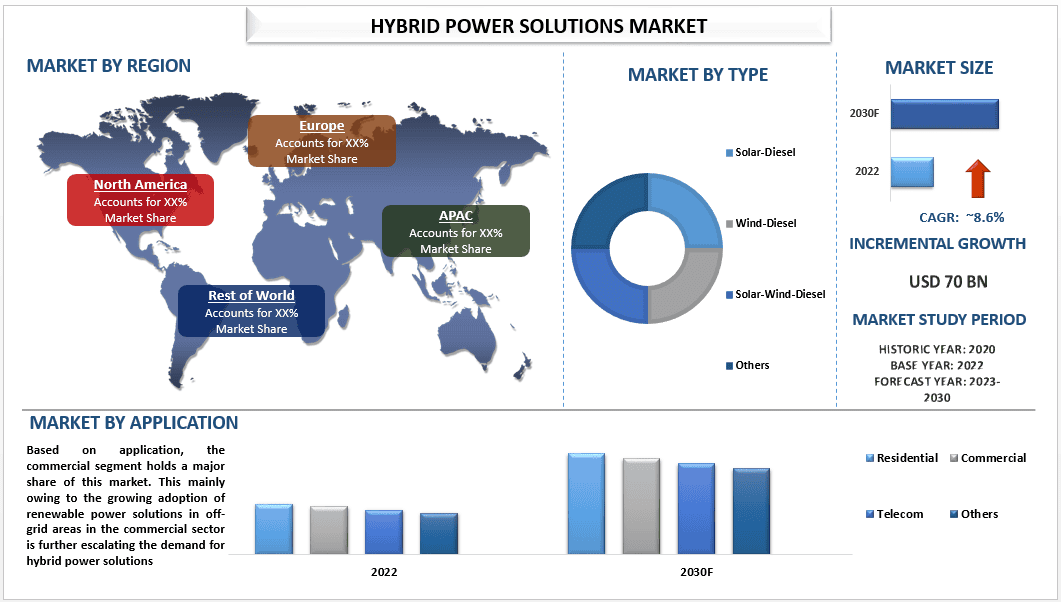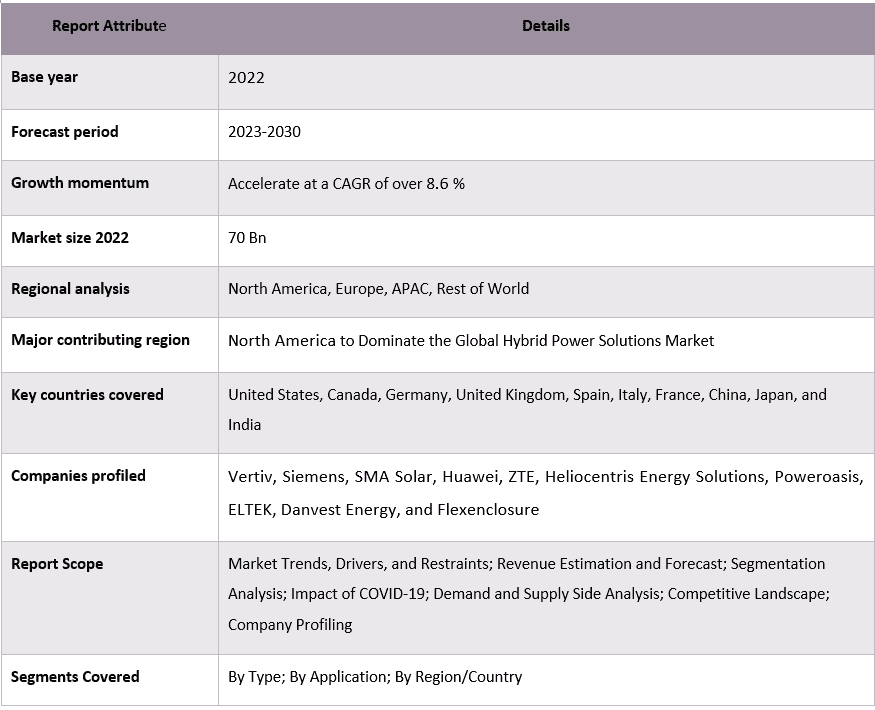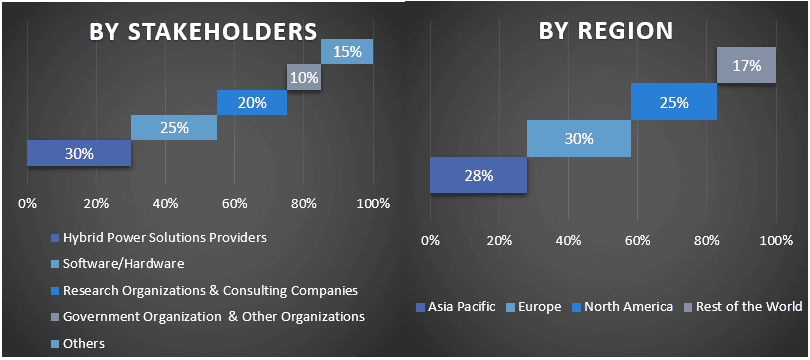
글로벌 하이브리드 전력 솔루션 시장은 예측 기간 동안 약 8.6%의 상당한 성장률로 성장할 것으로 예상됩니다. 정부 지원 증가, 탄소 배출량 감소 및 에너지 효율성 개선에 대한 집중과 같은 요인이 성장의 촉매제 역할을 합니다. 에너지, 자동차, 기술과 같은 산업의 주요 업체뿐만 아니라 스타트업 및 혁신 기업들이 하이브리드 전력 솔루션의 개발 및 채택에 적극적으로 기여하고 있습니다.
예시: 2023년 United Rentals는 "하이브리드 전력 솔루션: 휴대용 전력의 미래"라는 백서를 발표하여 BESS와 발전기를 결합하는 전략을 모색했습니다. "United Rentals는 기업이 수소 또는 프로판 발전기를 BESS와 함께 또는 자체적으로 사용하여 특정 전력 요구 사항을 해결하는 하이브리드 전력 솔루션을 활용하여 비즈니스를 민첩하고 대응적으로 유지할 수 있도록 지원할 수 있습니다.
Vertiv, Siemens, SMA Solar, Huawei, ZTE, Heliocentris Energy Solutions, Poweroasis, ELTEK, Danvest Energy 및 Flexenclosure는 시장의 주요 업체 중 일부입니다. 이러한 업체들은 고객에게 첨단 혁신적인 제품/기술을 제공하기 위해 여러 건의 M&A와 파트너십을 체결했습니다.
보고서에 제시된 통찰력
“유형 중 태양광-디젤 부문이 예측 기간 동안 더 높은 CAGR을 기록할 것입니다.”
유형에 따라 하이브리드 전력 솔루션은 다양한 유형으로 제공되지만 그중에서도 태양광-디젤 및 풍력-디젤 시스템이 가장 인기가 높습니다. 이러한 시스템은 그리드에 의존하지 않는 안정적이고 비용 효율적인 에너지원을 제공합니다. 태양광-디젤 하이브리드 시스템은 원격 또는 오프 그리드 위치와 같이 태양 복사량이 높은 지역에서 특히 인기가 높습니다.
낮에는 태양광 패널이 전기를 생산하고 디젤 발전기는 햇빛이 부족하거나 야간에 백업 전력을 제공합니다. 태양광 및 디젤 전력의 조합은 수입 화석 연료에 의존하지 않는 안정적인 에너지원을 보장하는 좋은 방법입니다.
“응용 분야 중 상업 부문이 2022년 시장에서 상당한 점유율을 차지할 것입니다.”
하이브리드 전력 솔루션 시장은 주거, 상업, 통신 및 기타의 4개 부문으로 분류됩니다. 상업 부문은 이 시장에서 큰 점유율을 차지합니다. 이는 주로 상업 부문에서 오프 그리드 지역에서 재생 에너지 솔루션의 채택이 증가함에 따라 하이브리드 전력 솔루션에 대한 수요가 더욱 증가하고 있기 때문입니다.
예시: 2020년, 몰디브가 비싸고 오염을 유발하는 디젤 연료에 대한 의존도를 줄이기 위해 아시아 개발 은행(ADB)과 몰디브 환경부는 지속 가능한 에너지 개발을 위한 외딴 섬 준비(POISED) 프로젝트를 시작했습니다. 이 이니셔티브에는 48개 섬에 태양광-배터리-디젤 하이브리드 시스템을 설치하는 것이 포함됩니다.
하이브리드 전력 솔루션 시장 보고서 범위

“북미가 시장에서 상당한 점유율을 차지할 것입니다.”
북미는 예측 기간 동안 상당한 성장률을 보일 것으로 예상됩니다. 이러한 성장을 이끄는 주요 요인은 기후 변화에 대한 우려 증가와 온실 가스 배출량 감소의 필요성입니다. 재생 가능 에너지원과 비재생 가능 에너지원을 결합한 하이브리드 전력 솔루션은 배출량을 줄이고 지속 가능성을 촉진하는 데 도움이 될 수 있습니다. 또한 안정적이고 비용 효율적인 에너지 솔루션에 대한 수요도 하이브리드 전력 솔루션에 대한 수요 증가에 기여하고 있습니다. 하이브리드 전력 솔루션은 날씨 조건에 영향을 받을 수 있는 태양광 또는 풍력과 같은 기존의 재생 에너지원과 달리 안정적이고 일관된 에너지 공급을 제공할 수 있습니다. 또한 값비싼 배터리 저장 시스템의 필요성을 줄여 기존 전력원보다 비용 효율적일 수 있습니다. 마지막으로 전기 자동차(EV)에 대한 수요 증가는 하이브리드 전력 솔루션에 대한 필요성을 주도하고 있습니다. EV는 충전을 위해 일관된 에너지 공급이 필요하며 하이브리드 전력 솔루션은 재생 가능 에너지원과 비재생 가능 에너지원의 장점을 결합하여 이러한 에너지 공급을 제공할 수 있습니다.
이 보고서를 구매해야 하는 이유:
- 이 연구에는 인증된 주요 업계 전문가가 검증한 시장 규모 측정 및 예측 분석이 포함되어 있습니다.
- 이 보고서는 전체 산업 성과에 대한 빠른 검토를 한눈에 제공합니다.
- 이 보고서는 주요 비즈니스 재무, 제품 포트폴리오, 확장 전략 및 최근 개발에 중점을 두고 주요 산업 동료에 대한 심층 분석을 다룹니다.
- 산업에 만연한 동인, 제약, 주요 동향 및 기회에 대한 자세한 조사.
- 이 연구는 다양한 부문에 걸쳐 시장을 포괄적으로 다룹니다.
- 산업에 대한 심층적인 지역 수준 분석.
사용자 정의 옵션:
글로벌 하이브리드 전력 솔루션 시장은 요구 사항 또는 기타 시장 부문에 따라 추가로 사용자 정의할 수 있습니다. 이 외에도 UMI는 귀하가 고유한 비즈니스 요구 사항을 가질 수 있음을 이해하므로 귀하의 요구 사항에 완전히 맞는 보고서를 얻으려면 주저하지 말고 저희에게 문의하십시오.
목차
하이브리드 전력 솔루션 시장 분석(2023-2030)을 위한 연구 방법론
글로벌 하이브리드 전력 솔루션 시장의 과거 시장 분석, 현재 시장 추정, 미래 시장 예측은 전 세계 주요 지역에서 하이브리드 전력 솔루션 도입을 분석하고 평가하기 위해 수행된 세 가지 주요 단계였습니다. 과거 시장 데이터를 수집하고 현재 시장 규모를 추정하기 위해 광범위한 2차 연구를 수행했습니다. 둘째, 이러한 통찰력을 검증하기 위해 수많은 발견 사항과 가정을 고려했습니다. 또한 글로벌 하이브리드 전력 솔루션 시장의 가치 사슬 전반에 걸쳐 업계 전문가와 광범위한 1차 인터뷰도 진행했습니다. 1차 인터뷰를 통해 시장 데이터에 대한 가정 및 검증 후, 전체 시장 규모를 예측하기 위해 하향식/상향식 접근 방식을 사용했습니다. 이후 시장 세분화 및 데이터 삼각 측정 방법을 채택하여 산업 관련 세그먼트 및 하위 세그먼트의 시장 규모를 추정하고 분석했습니다. 자세한 방법론은 아래에 설명되어 있습니다.
과거 시장 규모 분석
1단계: 2차 자료 심층 연구:
연간 보고서 및 재무제표, 실적 발표, 보도 자료 등 회사 내부 자료와 저널, 뉴스 및 기사, 정부 간행물, 경쟁사 간행물, 부문 보고서, 타사 데이터베이스 및 기타 신뢰할 수 있는 간행물을 포함한 외부 자료를 통해 하이브리드 전력 솔루션 시장의 과거 시장 규모를 얻기 위해 자세한 2차 연구를 수행했습니다.
2단계: 시장 세분화:
하이브리드 전력 솔루션 시장의 과거 시장 규모를 확보한 후 주요 지역의 다양한 세그먼트 및 하위 세그먼트에 대한 과거 시장 통찰력과 점유율을 수집하기 위해 자세한 2차 분석을 수행했습니다. 주요 세그먼트는 유형 및 애플리케이션으로 보고서에 포함되어 있습니다. 해당 지역에서 테스트 모델의 전반적인 도입을 평가하기 위해 추가 국가 수준 분석을 수행했습니다.
3단계: 요인 분석:
다양한 세그먼트 및 하위 세그먼트의 과거 시장 규모를 확보한 후 하이브리드 전력 솔루션 시장의 현재 시장 규모를 추정하기 위해 자세한 요인 분석을 수행했습니다. 또한 하이브리드 전력 솔루션의 유형 및 애플리케이션과 같은 종속 및 독립 변수를 사용하여 요인 분석을 수행했습니다. 전 세계 하이브리드 전력 솔루션 시장 부문에서 최고의 파트너십, 인수 합병, 사업 확장 및 제품 출시를 고려하여 수요 및 공급 측면 시나리오에 대한 철저한 분석을 수행했습니다.
현재 시장 규모 추정 및 예측
현재 시장 규모 측정: 위 3단계의 실행 가능한 통찰력을 기반으로 현재 시장 규모, 글로벌 하이브리드 전력 솔루션 시장의 주요 업체 및 세그먼트의 시장 점유율을 도출했습니다. 필요한 모든 백분율 점유율 분할 및 시장 분석은 위에서 언급한 2차 접근 방식을 사용하여 결정되었으며 1차 인터뷰를 통해 검증되었습니다.
추정 및 예측: 시장 추정 및 예측을 위해 이해 관계자에게 제공되는 동인 및 추세, 제약 및 기회를 포함한 다양한 요인에 가중치를 할당했습니다. 이러한 요인을 분석한 후 관련 예측 기술(즉, 하향식/상향식 접근 방식)을 적용하여 전 세계 주요 시장의 다양한 세그먼트 및 하위 세그먼트에 대한 2028년 시장 예측을 도출했습니다. 시장 규모를 추정하기 위해 채택된 연구 방법론은 다음을 포함합니다.
- 주요 국내 시장에서 하이브리드 전력 솔루션 시장의 수익(USD) 및 도입률 측면에서 업계의 시장 규모
- 시장 세그먼트 및 하위 세그먼트의 모든 백분율 점유율, 분할 및 분석
- 제공되는 제품 측면에서 글로벌 하이브리드 전력 솔루션 시장의 주요 업체. 또한 빠르게 성장하는 시장에서 경쟁하기 위해 이러한 업체가 채택한 성장 전략.
시장 규모 및 점유율 검증
1차 연구: 주요 지역 전반에 걸쳐 최고 경영진(CXO/VP, 영업 책임자, 마케팅 책임자, 운영 책임자, 지역 책임자, 국가 책임자 등)을 포함한 주요 오피니언 리더(KOL)와 심층 인터뷰를 진행했습니다. 그런 다음 1차 연구 결과를 요약하고 통계 분석을 수행하여 명시된 가설을 입증했습니다. 1차 연구의 입력은 2차 결과와 통합되어 정보를 실행 가능한 통찰력으로 전환했습니다.
다양한 지역의 1차 참가자 분할

시장 엔지니어링
글로벌 하이브리드 전력 솔루션 시장의 각 세그먼트 및 하위 세그먼트에 대한 정확한 통계 수치를 도출하고 전반적인 시장 추정을 완료하기 위해 데이터 삼각 측정 기술을 사용했습니다. 글로벌 하이브리드 전력 솔루션 시장에서 유형 및 애플리케이션 영역의 다양한 매개변수와 추세를 연구한 후 데이터를 여러 세그먼트 및 하위 세그먼트로 분할했습니다.
글로벌 하이브리드 전력 솔루션 시장 연구의 주요 목표
글로벌 하이브리드 전력 솔루션 시장의 현재 및 미래 시장 동향이 연구에서 정확히 지적되었습니다. 투자자는 연구에서 수행된 질적 및 양적 분석에 대한 재량적 투자 기반을 위한 전략적 통찰력을 얻을 수 있습니다. 현재 및 미래 시장 동향은 지역 수준에서 시장의 전반적인 매력도를 결정하여 산업 참가자가 미개척 시장을 활용하여 선점자 이점을 누릴 수 있는 플랫폼을 제공했습니다. 연구의 다른 양적 목표는 다음과 같습니다.
- 가치(USD) 측면에서 하이브리드 전력 솔루션 시장의 현재 및 예측 시장 규모를 분석합니다. 또한 다양한 세그먼트 및 하위 세그먼트의 현재 및 예측 시장 규모를 분석합니다.
- 연구의 세그먼트에는 유형 및 애플리케이션 영역이 포함됩니다.
- 하이브리드 전력 솔루션에 대한 규제 프레임워크 정의 및 분석
- 다양한 중개자의 존재와 관련된 가치 사슬을 분석하고 업계의 고객 및 경쟁사 행동을 분석합니다.
- 주요 지역의 하이브리드 전력 솔루션 시장의 현재 및 예측 시장 규모를 분석합니다.
- 보고서에서 연구된 지역의 주요 국가에는 아시아 태평양, 유럽, 북미 및 기타 지역이 포함됩니다.
- 하이브리드 전력 솔루션 시장의 회사 프로필과 빠르게 성장하는 시장에서 지속하기 위해 시장 플레이어가 채택한 성장 전략.
- 업계에 대한 심층적인 지역 수준 분석
자주 묻는 질문 자주 묻는 질문
Q1: 전 세계 하이브리드 전력 솔루션 시장의 현재 시장 규모와 성장 잠재력은 어느 정도입니까?
Q2: 전 세계 하이브리드 전력 솔루션 시장 성장의 주요 동인은 무엇입니까?
Q3: 유형별 글로벌 하이브리드 전력 솔루션 시장에서 가장 큰 비중을 차지하는 부문은 무엇입니까?
Q4: 글로벌 하이브리드 전력 솔루션 시장의 떠오르는 기술 및 트렌드는 무엇입니까?
Q5: 어느 지역이 글로벌 하이브리드 전력 솔루션 시장을 주도할 것인가?
Q6: 글로벌 하이브리드 전력 솔루션 시장에서 활동하는 주요 업체는 누구입니까?
관련 보고서
이 상품을 구매한 고객님들도 함께 구매하신 상품










